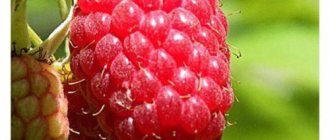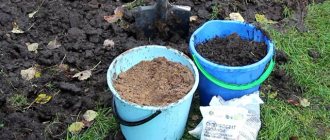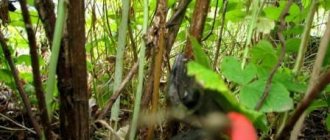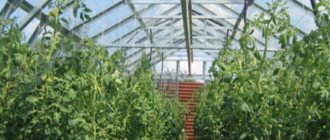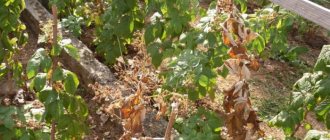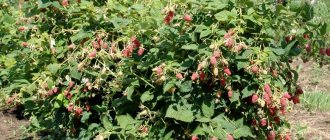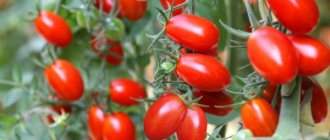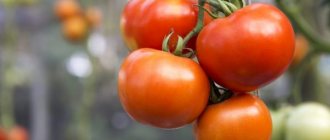The old raspberry variety “Kirzhach” is in particular demand. It has been known to experienced gardeners since the early 90s and has proven itself well for planting. The shrub, which is absolutely unpretentious in care and to the ground, is grown both in the northern part of the country and in the south. The berries grow sweet and are well transported and do not wrinkle.
Raspberries are often made into jam, ground with sugar into jam, or consumed fresh. Berries can be frozen in the freezer. In winter, you will have the opportunity to prepare a berry smoothie or bake a raspberry pie.
Raspberries have an anti-inflammatory effect and will relieve mild ailments and colds. They even help relieve headaches and reduce fever during illness. Not only berries benefit humans, but also raspberry leaves. The leaves are widely used in folk medicine. Their decoction or infusion is often used to treat diseases of the cardiovascular system and a number of gynecological diseases.
Description of the raspberry variety Kirzhach
The Kirzhach variety of raspberries was included in the State Register of the Russian Federation in 1994. Initially, it was recommended exclusively for cultivation in the climatic conditions of the south of the country. However, over time, the recommendations have been revised. Today it grows throughout the European part of Russia.
In terms of ripening time, mid-season Kirzhach raspberries are suitable for cultivation in Siberia and the Urals. However, this is hampered by its relatively low winter hardiness. The variety overwinters under snow at air temperatures of 20-25 degrees below zero.
Raspberries of the Kirzhach variety, descriptions and reviews of which are given in the article, are a vigorous plant with a large number of powerful, erect shoots. Even the stems of the current year, distinguished by their bright green color and a slight waxy coating, do not droop or bend towards the ground. In the second year, the bark on them becomes coarser and acquires a brown tint, which turns red as it grows. Rare soft thorns appear that do not interfere with harvesting. If you believe the photo, then Kirzhach raspberries can reach a height of 2-2.5 meters.
Bright shoots and a large number of small, ellipsoidal, slightly curling leaves with jagged edges make the plant incredibly decorative. And when raspberries just bloom dark green leaves with a glossy shine, and during the fruiting period and in the autumn months, when the bushes are covered with crimson. Kirzhach raspberries bloom from mid-June with small white flowers collected in inflorescences of 2-4 pieces.
Raspberry Kirzhach is not a remontant variety. However, it is distinguished by a long period of fruiting, which lasts from the second half of July to the end of August.
Raspberry Kirzhach, according to the description, forms small berries weighing about 2-3 grams. The shape of the fruit is cone-shaped, with a wide base. The fruits resemble classic forest raspberries, which is why gardeners love this variety. The berries are a rich crimson color, have juicy pulp and a small number of small seeds. Raspberries have a pronounced sweet and sour taste, refreshing, without cloying. The berries are very fragrant. Their aroma can be felt already within a radius of 2-3 meters from the bushes. The tasting score is 4.3-4.5 points out of five possible.
Origin story
The variety “Kirzhach” was developed not so long ago and belongs to the class of common raspberries. Registration and description of the variety in the state register dates back to 1994. "Kirzhach" was obtained by crossing the varieties "Carnival" and "Malling Promise". The selection process was led by Professor and Doctor of Biological Sciences Viktor Valeryanovich Kichina.
Read also: Planting raspberries in the fall: when, how and in what month is it better to plant
At the time of breeding, raspberry “Kirzhach” was the only one of all varieties that bore large berries. Now the shrub does not particularly stand out against the background of a wide variety of species.
Initially, the variety was actively grown in the North-Western and Volga-Vyatka regions, as well as in the territories of the North Caucasus and Ukraine. Over time, “Kirzhach” raspberries have become more widespread and can be used in any areas where winters are not very harsh.
Characteristics
If we talk about characteristics, Kirzhach raspberries have moderate frost resistance and weak drought resistance.
In the middle zone, raspberries do not need additional shelter. The root system of the plant grows not only in breadth, but also in depth. Therefore, frosts down to 25 degrees are not scary for her. Frozen shoots are simply removed in the spring. Raspberries quickly recover and bear fruit as usual.
As for drought resistance, the variety responds to moisture deficiency by producing abundant shoots to the detriment of yield. Therefore, in dry years, raspberries require abundant watering at the beginning of flowering and the fruiting period.
Features of fruiting
The berry crop is a mid-season variety with a long fruiting period. The first berries ripen in the middle or second half of July. The photo of Kirzhach raspberries clearly shows that the stems are strewn with bright, ripe berries and fruits that are just beginning to ripen. Under favorable weather conditions, harvesting can be done before the first days of autumn.
Thanks to this, Kirzhach raspberries have high yields despite the small size of the fruits. About 3 kg of aromatic berries are collected from one bush. They have dense flesh, which allows them to be stored for some time in a cool place and transported without losing their presentation.
Productivity is affected by good lighting, watering, fertilizing and regular lightening pruning of bushes.
Raspberries are good fresh. But it is better suited for processing. Jams and jams are made from the berries. Compotes and juices are prepared for the winter. All preparations are distinguished by their rich color and pleasant aroma of forest raspberries.
"Pros and cons"
Raspberries of the Kirzhach variety receive varied reviews. The variety has many fans and many opponents, who believe that today it is easy to find larger-fruited varieties with better taste characteristics. When discussing its merits, they talk about:
- unpretentiousness of the variety;
- its resistance to sudden weather changes;
- high yield;
- long period of fruiting;
- bright aroma and taste of berries;
- keeping quality and transportability;
- having immunity to most diseases.
Care
If you already have fruit and berry crops on your site, then you will not experience any particular difficulties. All activities should be carried out on schedule and in full.
Watering
- An important and necessary procedure, because for raspberries the fundamental factor is that the root system develops well and grows deep into the soil and receives enough nutrients.
- The soil should be soaked to a depth of 30 - 35 cm. After watering, loosen the soil so that a crust does not form. The number of waterings per season is at least 6 - 8 times.
Fertilizer
In the spring, when loosening the soil, add 8 kg of mullein per 1 m2, as well as 20 grams of urea per bucket of water (especially in the first year of life). Treatment with boric acid (20 g per bucket of water) is applied during raspberry flowering.
During the formation of berries, water the roots with a solution of nitrophoska (20 - 30 grams per bucket of water). In the fall, add superphosphate (25 g per 10 l) and potassium chloride (10 - 15 g per 10 l of water).
Features of reproduction
Like most varieties, Kirzhach raspberries are propagated by cuttings and layering. Cuttings 15-20 cm long with 2-3 strong buds are cut in the fall from two-year-old shoots. Gardeners store them in the refrigerator until spring or plant them in greenhouses for the winter, providing additional shelter. By spring, seedlings with several roots will be ready.
In the spring, layering is placed in prepared trenches, secured with staples and dug in, leaving the top. Planting material will be ready by autumn. However, this method of propagation for Kirzhach raspberries is not entirely suitable. The shoots of the plant are very strong.
Possible diseases and pests
Root cancer
Variety Kirzhach is resistant to anthracnose and spider mites, but is susceptible to infection by other diseases and pests:
- root cancer;
- purple spotting;
- curly;
- raspberry flower beetle;
- gall midge.
To avoid troubles associated with plant diseases, in the spring, after three leaves appear, the bushes are sprayed with the insecticides Ridomil and Fufanon. 25 g of the first drug are dissolved in a bucket of water, the second substance is enough to use 2 g for the same amount of liquid.
How to plant correctly
Seedlings are planted mainly in early autumn. The best period for the middle zone is September and October. Raspberries will have time to take root before the cold weather. In regions with cold climates, planting occurs in late April or early May. In this case, the plants need to be provided with timely and abundant watering.
Raspberry Kirzhach prefers to grow in well-lit places, protected from gusts of wind. Soils suitable are light sandy loam or loamy. Of course, the best results will be in fertile or well-fertilized areas.
Raspberry Kirzhach reacts negatively to stagnation of moisture at the roots. When planting, avoid lowlands, wetlands and places where moisture accumulates during snow melting and heavy rains.
Attention!
Tall, overgrown bushes can interfere with sunlight access to other crops. Due to the height of the bushes, growing Kirzhach raspberries next to fruit trees is not recommended. Many people prefer to plant seedlings on the south or east side of fences.
Kirzhach raspberries are planted both in holes and in trenches if there are a lot of seedlings. The planting depth is calculated so that the first bud of the seedling is at a height of 3-5 cm above ground level.
- A mixture of soil with rotted compost or humus in a ratio of 2 to 1 is placed in the holes. For poor soils, you can prepare a composition of equal parts of the components.
- Before planting, the roots of the plant are dipped in clay mash or sprinkled with wood ash.
- Tall Kirzhach raspberries are planted at a distance of 70-80 cm from each other. The holes are closed.
- The plantings are watered abundantly and mulched with sawdust.
For the winter, many people use compost as mulch.
Preparing for landing
Planting raspberries in autumn is carried out in the south at the end of September and beginning of October. In the north, gardeners recommend planting in the spring so that with the onset of early cold weather the plant does not freeze. For the middle zone, it is better to carry out the procedure in the fall; it is also allowed in the spring.
Be sure to choose a sunny area. Do not give preference to shaded areas with strong winds. Sandy and loamy soils are especially suitable for raspberries. Do not plant the plant in lowlands, on steep slopes, or in open hills.
Before planting, cuttings are soaked in a solution, which helps prevent the development of diseases. It is important to prune weak shoots, which will speed up the growth of the plant. It is advisable to plant when the soil is still moist - in spring or autumn after rain.
The best predecessors for raspberries are carrots, garlic, beets, and onions. It is not advisable to plant shrubs where tomatoes or potatoes used to grow. The main thing in preparation is to dig up the soil and apply fertilizer.
Reviews from gardeners about Kirzhach raspberries
Elena, 32 years old, Bryansk Raspberry Kirzhach is an amazing variety. A small corner of the forest in the garden. The variety is truly unpretentious. The main care is watering and preparing for winter. There is no need to cover it. Yes, and it won’t be possible to do this. The shoots are too strong and long. The berries are small but very tasty.
Margarita, 45 years old, Voronezh Malina Kirzhach settled with us 4 years ago and I hope for a long time. She has excellent taste. The berries do not fall off and do not bake in the sun. The first point is very important for us - we are at the dacha only on weekends. It bears fruit for a long time. And most importantly. Malina Kirzhach tolerates transportation well. It arrives home as if it were fresh, just assembled. And this is 60 km after all.
